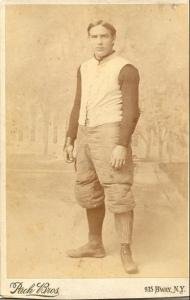Why Telling Family Stories Matters — Scientifically
My great-grandfather played football in the 1900s
Why should you put preserving and sharing old pictures and family stories at the top of your “to do” list?
This research by Drs. Marshall Duke and Robyn Fivush of Emory University may be sufficiently compelling: “Family Narratives”
“Adolescents who know more family history show higher self-esteem, lower levels of behavior problems, such as withdrawal and aggression, higher sense of self-efficacy, and a more differentiated sense of self.
The family stories we tell our children are quite important and old family pictures are an easy catalyst for such conversation.
Try putting an interesting old family picture as the computer screen saver or display some on a digital picture frame. I bet you’ll catch your child’s interest and attention. Print, frame and hang old family pictures in the hallway.
Photographs allow the memory-impaired access and connection with their former selves.
Children and adolescents are not the only family who benefit from sharing family pictures and stories. Our family members who suffer from Alzheimer’s, dementia or brain trauma benefit as well. Abundant anecdotal evidence suggests the use of photographs with memory-impaired individuals allows access lost memories and connection with their former selves. Pictures let caregivers and therapists to see their patient as their former selves, making it easier to connect.
I created a photo calendar for my mother-in-law of pictures of her as a baby and as a teen, of her parents, her husband and children, and of her favorite hobbies. She loved it. The pictures encouraged her to refer to the calendar to help remember her activities, medications and her track the days. It was also an easy way for caregivers to know her better. It is one of the most meaningful gifts I’ve ever given.
Dig out those old pictures. Bring those pictures and stories of your family’s heroes and characters into the life of your family. Old or young, it matters.



